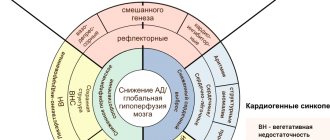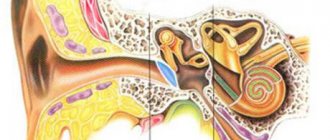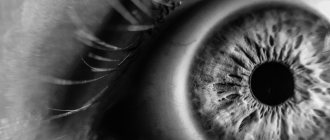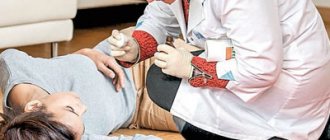Pyramidal or pyramidal insufficiency syndrome is a violation of the tone of the muscles of the extremities, especially the lower ones. This pathology is also called “toe walking” or “ballerina symptom.” Often accompanied by equinus or equinovarus foot placement (the feet seem to move apart in different directions, and the ankle “falls” inward). This condition is often diagnosed in children in the first year of life (before the child learns to walk), less often in two or three year old children. Like the consequences of meningitis, head injury and other lesions of the nervous system, they can develop in adulthood.
Why does pyramidal insufficiency syndrome occur?
The medulla oblongata, whose cells are called “pyramids,” is responsible for complex reflexes in the human body. It is as a result of any disturbances in this part of the brain that the so-called pyramidal insufficiency occurs, i.e., disturbances in the adequacy of reflexes. The most common causes of deficiency are:
- congenital pathologies of the NS,
- birth injuries,
- fetal hypoxia during pregnancy or childbirth,
- disruption of the production or outflow of cerebrospinal fluid (cerebrospinal fluid),
- infectious diseases,
- abscesses,
- inflammation of the meninges that cause hydrocephalus (meningitis, encephalitis),
- tumors
- cerebral hemorrhages.
Pyramidal insufficiency syndrome is by and large not a separate disease. This is a secondary condition caused by an underlying disease of the nervous system. It is worth noting that in infancy (2-3 months), tightening of the legs and hypertonicity of the lower leg muscles is not a terrible pathology. As the nervous system ages and matures, this condition usually goes away.
About neurological problems in general and pyramidal insufficiency in particular
Hello Asya!
I am writing in detail, because your letter is the last straw that has filled my patience with pyramidal insufficiency...
To begin with, the answer to the main question - what is pyramidal insufficiency? The most difficult thing here is to explain the meaning of the adjective “pyramidal”. To do this, you need to travel into the terrible jungle of anatomy and physiology of the nervous system. I’ll note right away that this section is, in principle, one of the most difficult in both anatomy and physiology, and most medical students. Institutes have a nervous breakdown at the mere thought that this topic will appear on the exam paper. However, I will try to explain it very briefly.
There is a certain area in the cerebral cortex responsible for voluntary muscle contractions. Those. if we want to move a finger or throw back our head, then the signal from the cells in the mentioned area of \u200b\u200bthe cortex descends along the corresponding processes and reaches a certain segment of the spinal cord. This section of the nervous system, from cells in the cortex to a specific segment of the spinal cord, is called the pyramidal tract.
The pyramids are anatomical sections of the medulla oblongata, the nerve impulse passes through them, hence the name. Medical manuals describe the pyramidal tract as “an efferent projection neural pathway originating in the precentral gyrus cortex and extending to the cranial nerve nuclei and motor neurons of the spinal cord.” I give this quote only as an illustration, so that my statements about the complexity of the issue do not seem unfounded.
Inflammatory processes, tumors, hemorrhages, some infections and congenital diseases can lead to cell damage on some part of the pyramidal tract and this will manifest itself in very specific symptoms - movement disorders, and taking into account the fact that it has stopped moving, a competent neuropathologist can accurately determine the specific the area where the lesion is located. Recently, due to the advent of computed tomography, fewer and fewer neurologists have the necessary knowledge, because the device accurately indicates the lesion and there is no need to walk around the patient for hours with a hammer in his hands, in order to assume that there is something happened. Assuming that after my descriptions
You understand the meaning of the word “pyramidal”, then answering the question of what pyramidal insufficiency is is still not easy. There is no such diagnosis in the international classification of diseases. In the textbook for medical students. Institutes of Child Neurology - there is no such diagnosis. There is no such diagnosis in the detailed monograph (530 pages) entitled “Guide to the Neurology of Early Childhood.” But hundreds of neurologists make this “diagnosis” for thousands of children. Most likely, the reasoning algorithm looks like this: the child has some disorders in the motor sphere, or the disorders are not detected, but the mother complains. The fact that the head is thrown back, the chin is trembling, the fact that it often looks to the left rather than forward, the fact that it jerks its legs, waves its arms, etc. The doctor cannot detect any serious illnesses - there are no specific symptoms - as in your letter - “the child is calm and cheerful.” But how can you tell your mom that everything is okay if she complains!!! It is necessary to make at least some kind of diagnosis, because if, in response to complaints, you say that you don’t need to fool yourself and the doctor, then this will definitely be regarded as a sign of inattention, negligence, and unprofessionalism. And, most importantly, if no diagnosis is made in response to complaints, then tomorrow the mother and child will be in the office of another neurologist, who will treat her “carefully and professionally,” make a diagnosis and prescribe treatment. So a diagnosis appears, which cannot be translated into Russian, but is very scientific and beautiful: “pyramidal insufficiency.” Which, in this context, can be translated as “unexplained problems in the motor sphere.”
Pyramidal insufficiency is just one of the diagnoses, but there are others that are no less common. Here we have minimal cerebral dysfunction syndrome, various types of encephalopathies, liquor hypertension syndrome, etc. There are real neurological problems - congenital malformations of the nervous system, birth injuries, brain damage due to oxygen deficiency during childbirth, infectious diseases - meningitis, encephalitis, tumors and abscesses in the brain or spinal cord, disturbances in the production and outflow of cerebrospinal fluid, leading to serious illness hydrocephalus. All these diseases have very specific symptoms and very specific treatment methods. At the same time, the nervous system of a child in the first year of life is functionally immature; during its formation, symptoms may occasionally appear that are one of the signs of a serious illness, but there are no other symptoms, and the existing dangerous symptom disappears after a while. Head tilt is one of the signs of meningitis, but no one diagnoses meningitis based on this symptom alone. Nevertheless, tens of thousands of children in the first year of life are treated under the supervision of neurologists, in the absence of specific diagnoses. This happens due to our exclusively domestic mentality and our specific characteristics in the relationship between doctors and parents.
To begin with, I will note that I personally have always been amazed by the amazing feature of our mothers. An American gives birth to a child with Down's disease and spends her whole life trying to prove that her Down is the smartest. Ours deliberately look for illnesses and shortcomings in their own children, and moreover, they are indignant if the doctor does not agree with them. And in no other country in the world are there so many meaningless diagnoses that pursue one single goal: to satisfy parents in their desire to treat their own child. Neurological problems in this aspect are only a special case, from the same series as dysbiosis, unknown to anyone in the world, rare lactase deficiency, diathesis, etc. Can you imagine that in a country with paid healthcare, a mother would go not to her family doctor, but to a very rare and very, very expensive specialist - a pediatric neurologist, provided that the child is cheerful, calm and cheerful, but sometimes throws his head back ? Rhetorical question...
The most dangerous thing, from my point of view, is that the matter is not limited to one diagnosis. The doctor simply cannot afford not to respond to his own diagnosis by prescribing medications. And if he doesn’t appoint, then everything will go according to the scheme described above - Maria Petrovna won’t appoint today, tomorrow dear Ivan Ivanovich will come to the house and will definitely appoint. There is such a wonderful Ukrainian joke. Two godfathers with heavy bags rush along the station platform - they are late for the train. And so, when the goal is already close, the doors close right in front of their noses and the train moves off. One of the godfathers puts the bags on the ground and hits the second one in the face as hard as he can. He shouts: “For what!!?” The first one answers: “So we need work” (For what? So we have to do something). Logically, you should calmly wait for the next train. But this is not for us. It’s the same in a neurologist’s office - most medications are prescribed precisely because “work is required”... But waiting, observing without fussing is not for us.
The great and wise Avicenna wrote a thousand years ago: “If the disease is difficult to determine, then do not interfere and take your time. Truly, either the being (of man) will prevail over the disease, or the disease will be determined! "
This, although difficult, could be tolerated if the prescribed medications were absolutely safe. But drugs with serious side effects are often used. In addition, there is simply a pathological desire to treat children with injections.
In principle, I cannot imagine a situation in which injections of vitamin B12, or ATP, or B6, or, even worse, magnesium, can cure a child of any neurological disease. But the list is not limited to this. Quite often there are diuretics (diacarb, triampur), experiments with dietary supplements, powerful stimulants of metabolic processes. I want to emphasize again. There is a specific problem. For example, neuritis of the facial nerve, or obstetric paresis of the arm, or traumatic brain injury. There is a specific treatment regimen - medications, massage, and physiotherapy (electrophoresis, for example). Those. We are not talking at all about rejecting the achievements of medicine in general and pharmacology in particular, and not paying attention to the disease. But in a situation where the symptoms are insignificant, episodic or vague, it is better not to do anything, because the intensity of metabolic processes in a child, especially in the first year of life, is so high that it can be improved with drugs to a very small extent.
And, if it were up to me, I would write the above quote from Avicenna in capital letters and hang it at the entrance to every clinic. It is impossible not to mention this unfortunately present phenomenon, when both diagnoses and prescriptions relate exclusively to the field of commerce. When a doctor sells dietary supplements or receives a percentage from pharmacists for prescribed drugs, when a paid massage is prescribed, which certainly won’t make things worse, when the doctor is aware that he is “healthy” for the diagnosis - they won’t say thank you, but the responsibility for the rest life, and for the illness, treatment and obvious improvement (which only the doctor can see) they will thank you and provide financial assistance...
All the best.
Komarovsky Evgeniy Olegovich - Komarovsky E. O.
Symptoms of pyramidal insufficiency in children
Pyramidal insufficiency in children manifests itself in
- weak grasp reflex in infancy and difficulties with holding objects at an older age,
- tremors of the arms, legs or chin,
- throwing your head back,
- walking only on toes without support on the heel,
- in a standing position - tuck your toes.
Making such a diagnosis is often unjustified, and it only means hypertonicity of the calf muscles without any other symptoms. We can talk about real insufficiency only when the child can already walk freely, but at the same time steps only on his toes, plus he has other symptoms of dysfunction of the nervous system. However, if you find any of the listed symptoms in your child, consult a pediatric neurologist, because simple hypertension sometimes hides serious illnesses that can lead to delayed physical (or even mental) development.
Treatment
With a movement disorder, it all depends on the cause. If a stroke occurs, then prompt activation of the patient is extremely important; massage is needed for pyramidal insufficiency.
Treatment of the most abstract “deficiency” is carried out only in a child, and only if, for some reason, the maturation of his motor bundles is simply delayed. This can be due to perinatal pathology, with a general slowdown in development. In this case, you need gymnastics, swimming, and work with a specialist in physical therapy.
By the way, recently “emendic massage” has appeared, the source of which is the Moscow clinic “Emendo”. In particular, it is indicated for pyramidal insufficiency. In any case, the clinic’s website states that, unlike the author’s, classical methods are ineffective.
Diagnosis of pyramidal insufficiency
First of all, an examination is carried out by a pediatric neurologist, who conducts various tests for age-related reflexes. Very effective and indicative diagnostic tools are tomography and electroencephalography. In cases where a child not only experiences convulsive muscle twitching, but also a fever, lethargy, etc., a spinal cord puncture may be prescribed to identify the underlying disease that requires urgent treatment (for example, meningitis).
Anatomical certificate
The medulla oblongata, which connects the brain to the spinal cord, is responsible for complex reflexes. This organ consists of cells of a special pyramidal shape, which are called pyramids. That is why the syndrome is called pyramidal. Impaired coordination of movements is a consequence of damage to the above-mentioned cells.
It is curious that there is no official symptom of “pyramidal insufficiency”. However, it is given to young children - and not always justified.
The main reason for the development of such a pathology in an infant is mechanical or ischemic intrauterine injury to the cervical spinal cord. When blood flow in the cervical thickening and brain stem is disrupted, the muscle tone of the limb flexors undergoes a significant deviation from the norm.
The severity of the syndrome is directly dependent on the severity of brain damage. A mild form of insufficiency manifests itself in stiffness of the arms, and more common ischemia adds to the symptoms of impaired motor activity of the lower extremities: when trying to put the baby on his feet, he stubbornly rests only on his toes, that is, the distal part of the foot works.
Treatment of pyramidal insufficiency in children
In the case of real pyramidal insufficiency, medical measures are aimed at treating the underlying disease that caused this insufficiency, including surgical intervention. However, in most cases, apart from hypertonicity of the lower leg, no other symptoms are detected. In this case, the main treatment is to relieve hypertonicity and form the correct position of the ankle joint.
- Massage and exercise therapy. It is important to combine visits to an experienced specialist who can relax and strengthen muscles with light massages at home. Swimming and light physical exercise also contribute to the proper development of muscles and joints, and the formation of good coordination of movements. To restore energy metabolism and the proper flow of fluids in the body, you can contact an osteopath.
- Orthopedic shoes. If pyramidal insufficiency is discovered at an age when the child has already begun to walk, it is important to correctly form the ankle joint, since its incorrect position will lead not only to injuries to the ankle, but also to disruption of the entire musculoskeletal system.
- Vitamin therapy.
- Sometimes medications are prescribed to improve metabolic processes and nerve conduction.
Childhood lays the foundation for health for the rest of your life. It is very important to respond to any deviations from the norm in a timely manner so as not to miss a serious illness that can significantly reduce a person’s quality of life. If you suspect any pathology or you just want to know that everything is fine with your child, contact our Aximed neurology clinic. Our doctors are qualified specialists with many years of experience; the clinic is equipped with the most modern equipment and has the latest diagnostic tools. With us you will receive a comprehensive diagnosis and comprehensive consultation from the best neurologists in Kyiv.
Advantages of treating pyramidal syndrome at the Neonatus Sanus Osteopathy Clinic
Our clinic of osteopathy and neurology on Vasilyevsky Island “Neonatus Sanus” - health from birth, has extensive practical experience in the prevention and treatment of newborns, infants and infants.
We know how and love to work with young children!
Our clinic employs experienced osteopathic doctors and neurologists, which expands the possibilities of diagnosing and treating this condition. A lot of attention is paid to each child in order to understand the child, accurately assess his condition, give recommendations to parents and, if necessary, carry out effective osteopathic treatment.
In our center you can get the best examination, treatment and recommendations from leading specialists in St. Petersburg.
Development of the disorder
Features of the development of pyramidal insufficiency depend on changes in muscle tone and the level of damage to the nervous system (NS).
For example, with central paralysis (incomplete loss of voluntary movements - central paresis), a neuron is disinhibited in the spinal cord. The pyramidal system begins to send a huge number of nerve impulses to the muscles, thereby increasing reflexes and muscle tone. In addition, tremors also appear.
As for flaccid paralysis (paresis) or peripheral, it is formed when a neuron and its process in the spinal cord are damaged. Muscle tone decreases, until the muscle completely immobilizes. Reflexes decline or disappear completely, after which hypotrophy of the innervated area occurs.
Clinical paralysis (paresis) in the lower extremities - tremor and tension appear in the legs, tone increases, gait becomes different. The leg is unbent with difficulty, the foot is placed on the toe, and the impression of steppage (“rooster gait”) is created.
Clinical paralysis (paresis) of the upper extremities - a tremor occurs in the hands; in order to lift something, enormous effort is required due to increased muscle tone. Malnutrition or atrophy begins to develop.
Causes of the disease in adults:
- inflammation in the brain (meningitis, encephalitis);
- changes in hemodynamics in the brain (heart attack, stroke);
- head injuries that cause disturbances in the transmission of nerve impulses;
- benign and oncological tumors.
Causes of the disease in children:
- hypoxia;
- infectious diseases;
- inflammatory processes;
- birth injuries;
- intrauterine developmental anomalies.
Are there neurological problems in children?
When diagnosed with pyramidal insufficiency, the following neurological problems may well occur:
- various injuries that occur during childbirth;
- congenital diseases of the nervous system (cerebral palsy, spinal dysraphism, infantile hydrocephalus, etc.);
- brain hypoxia;
- diseases caused by the penetration of pathogenic microorganisms and viruses into the body;
- tumors;
- purulent inflammation in the spinal cord or brain;
- disturbances in the production and outflow of cerebrospinal fluid (cerebrospinal fluid);
- encephalitis and meningitis.
Each of the above pathologies has its own characteristic symptoms and methods of treatment.
Establishing diagnosis
Methods for diagnosing pyramidal insufficiency:
- MRI (if there are seizures/spasms or the doctor suspects epilepsy);
- CT scan of the brain (used as an additional research method);
- electromyography (the neuromuscular system is checked by recording muscle potentials);
- Ultrasound of the brain (helps detect tumor processes);
- EEG (detects hidden seizures that occur during sleep).
In addition to the above methods, tests will be required to confirm the syndrome.










